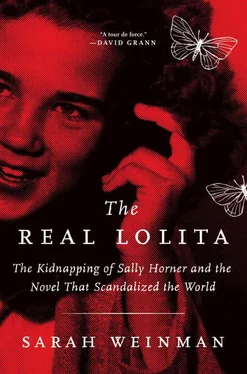Here, so late in Lolita, Humbert has his moment of reckoning. He understands, briefly, “what he might really look like in the eyes of his eternal jury: children and their protectors.” The glib charm, all of the smooth veneer, is stripped away in an instant. Humbert reveals himself as the monster he knows he is. And by killing Clare Quilty for taking Dolores away from him—in his mind, taking away what was rightfully his— Humbert Humbert loses his last vestige of morality.
Dolinin takes a charitable view of Nabokov’s treatment of Sally Horner in Lolita, claiming that the number of references, including the architecture of the novel’s second half, does not obscure the real girl. Rather, he writes, “[Nabokov] wanted us to remember and pity the poor girl whose stolen childhood and untimely death helped to give birth to his (not Humbert Humbert’s) Lolita—the genuine heroine of the novel hidden behind the narrator’s self-indulgent verbosity.”
This sense of pity Dolinin speaks of emerges in Humbert’s final meeting with Dolores. She is married, pregnant, and seventeen, with “adult, rope-veined narrow hands.” She has aged out of his perverse desires, and he finally understands, through the use of the parenthetical, how much he defiled and violated her, how much damage he has caused:
“…in the infinite run it does not matter a jot that a North American girl-child named Dolores Haze had been deprived of her childhood by a maniac, unless this can be proven (and if it can, then life is a joke), I see nothing for the treatment of my misery but the melancholy… palliative of articulate art.”
Humbert’s epiphany is in keeping with Véra’s diary note only days after the American publication of Lolita in 1958. She was ecstatic about the largely positive press and fast sales of the novel, but was unnerved by what critics weren’t saying. “I wish, though, somebody would notice the tender description of the child’s helplessness, her pathetic dependence on monstrous HH, and her heartrending courage all along.”
It is to Nabokov’s credit that something of the true character of Dolores—her messy, complicated, childish self—emerges out of the haze of his narrator’s perverse pedestal-placing. She is no “charming brat lifted from an ordinary existence only by the special brand of love.” She excels at tennis; she is free with sharp comebacks (“You talk like a book, Dad ”); and when she seizes the opportunity to break away from Humbert and run off with Clare Quilty, she does so in order to survive. Any fate is better than staying with her stepfather.
Never mind that she will, later, run from Quilty’s desire to embroil her in pornography with multiple people. Never mind that Dolores will “settle” for Dick Schiller and a life of domesticity and motherhood that is, sadly, cut short. She still has the freedom and the autonomy to make these choices for herself, a freedom she never had while under Humbert Humbert’s power.
These choices are likely why Véra rated Dolores so highly in the diary entry, and why Nabokov himself ranked Lolita second (after Pnin) of all the characters he ever created that he admired most as a person.
Twenty-Three
“A Darn Nice Girl”
On August 21, 1952, three days after the car accident that killed Sally Horner, the Vineland Daily Journal published a front-page interview with Edward Baker. He said he was “bewildered by publicity” over Sally’s death. “I’d never met Sally before. She didn’t tell me if she had ever been to Wildwood before, but I got the impression this was probably the first time she’d ever visited the place.” Baker said he frequented the resort town “just about every weekend.” On Friday, August 15, he left early from Kimble’s, the glass plant where he worked as an apprentice machinist. He met Sally the next day, as well as “a whole bunch of other fellows and girls I met down there… Sally and I hung around with them most of the time.”
He insisted news accounts of the car accident were wrong. “The fellow who owned the truck I hit [Benson] said he was on the shoulder of the road. But I certainly wasn’t on the shoulder, and my skidmarks will prove it. The fellow behind me, even with the benefit of my lights, didn’t see the truck, and he crashed into it also.” Baker said that what saved his life was the fact that he had both of his hands on the steering wheel, which broke in the collision.
Three days of coast-to-coast news stories had rattled Baker’s nerves, and he wanted to set the record straight about what happened between him and Sally. “She seemed like a nice girl. Some of the stories that followed the accident sounded as though we were making a sinful weekend of it. We didn’t do anything wrong…. We weren’t ‘fooling around’ in the car, or anything. If we had been, she probably wouldn’t have been killed and I might have been.”
Baker was even more flabbergasted by the revelations of Sally’s past ordeal. “Nobody had any idea this girl was the one who had been kidnapped four years ago. How should we remember?” Never mind that Sally’s rescue was reported nationwide, as well as on the front page of the Daily Journal .
He was still grappling with how young Sally really was. “She told me she was 17 years old. She may have had a birth certificate with her saying she was 21, but I never saw it. Who asks to see birth certificates when you go out with a girl?”
The Daily Journal also spoke to Baker’s mother, Marie Young. She’d received a call from her son not long after the accident. “He said he wished it was him that was killed instead of that innocent girl. He was pretty broken up.” He’d told his mother how nice a girl she was, and how he admired her commitment to going to church on Sundays, even down in Wildwood. He would never get past that “she got killed because she wanted him to take her into Vineland.”
Both Baker and his mother had added reasons to defend themselves. After he was treated at Burdette Tomlin Hospital in Cape May for the injuries he sustained in the car accident, police arrested and charged him with reckless homicide. Baker was freed on a thousand dollars’ bail—his stepfather, James Young, put up the money—on August 20. A news account sympathetic to Baker, stressing his lack of culpability in the accident, might help his case.
But a strike against him was that the crash leading to Sally’s death was not Baker’s first car accident. Only the year before, Baker was driving the car, which belonged to his mother, Marie Young, in Newfield, four miles north of Vineland. He hit another car while running a red light. Then, too, Baker’s injuries were not life-threatening. Neither were those of Marie, sitting in the passenger seat.
SALLY HORNER’S FUNERAL was held on August 22, four days after her death. More than three hundred people crowded into the Frank J. Leonard Funeral Home at 1451 Broadway to pay their respects. Many floral arrangements sent by well-wishers flanked Sally’s casket.
The burial was a more private affair. Only a handful of family members, including Ella, Susan, Al, and some aunts and cousins, drove out to Emleys Hill Cemetery in Cream Ridge, where Sally’s remains were interred in the Goff family plot.
For Carol Starts, the funeral was awful. She sat by herself in a corner pew. Ella and Susan requested the casket be open at first, for those who wished to pay their last respects to Sally. “I wanted to see her so badly. Then I did, and it nearly broke me in half,” Carol recalled. When she could no longer stand the proceedings, Carol fled the service and went home.
Carol stayed away from school for an entire week after Sally’s death. “I couldn’t handle it. This was the most heavy-duty thing I had ever gone through.” Carol’s first experience of deep loss would mark her for the rest of her life. As she grew older and friends began to die, Carol tended to grieve in an open and wild manner that puzzled those around her. “I would hear, ‘but they were just a friend.’ I would hear that about Sally. That we should be moving right along. I wasn’t willing to move right along. I wanted to grieve. And when I finally came out of shock, I did.”
Читать дальше












